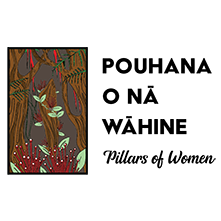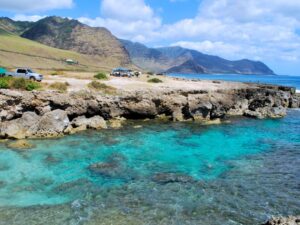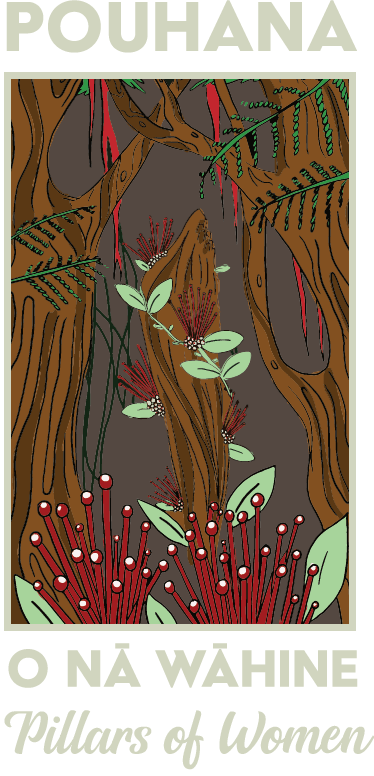Hoʻi i Ka Hale by Kekoa Kekuawela Rosa
(Director of Training & Technical Assistance, Pouhana O Nā Wāhine)
Ano ai me ke aloha,
ʻO Sterling Michael Rosa ke kāne, no Germany
 ʻO Melissa Ann Kekuawela ka wahine, no San Leandro, California
ʻO Melissa Ann Kekuawela ka wahine, no San Leandro, California
Noho pū lāua a hānau maila ʻo Kekoa Michael Kekuawela Rosa. He māhū.
ʻO Oahu o Kākuhihewa kuʻu one hānau.
ʻO Ko’olaupoko kuʻu moku.
ʻO Kahalu’u kuʻu wai.
ʻO pu’umā’eli’eli kuʻu mauna.
ʻO Pō’aihala kuʻu ua.
ʻO Mololani kuʻu makani.
I want to express my deepest gratitude for your presence today, under the watchful eyes of Koʻolaupoko. These mountains, which have seen generations rise and fall, stand as silent witnesses to the tides of time, the ebb and flow of our people, and the resilience of our culture.
Koʻolaupoko is more than a picturesque backdrop; it is the very breath and pulse of my identity. Kahaluʻu Elementary, being my school, KEY project being one of my first jobs teaching keiki in the summers, and Ahuimanu now being my home It was here, in the embrace of these ridges and valleys, that I first learned what it means to be Hawaiian. This land shaped my understanding of ʻohana—not just as a concept, but as a lived experience, deeply rooted in the earth beneath our feet and the sky above our heads.
As we come together for this inaugural conference, I am reminded that this is not just a gathering—it is a homecoming. It is a return to the essence of who we are as a people. Today, we do more than convene; we reconnect with our ancestors, our culture, and with each other, as we explore the profound meanings of ʻohana, identity, and resilience.
Let us take a moment to reflect on the significance of Koʻolaupoko, these towering peaks that have nurtured and protected us. In many ways, Koʻolaupoko embodies the spiritual and physical essence of our ancestors. The mountains are more than geological formations—they are kupuna, ancient ones who have witnessed the unfolding of our stories and continue to guide us.
Growing up in the shadow of these mountains, I learned that the land is not something we own; it is something we belong to. Koʻolaupoko has always been a place of refuge, a source of wisdom, and a teacher of resilience. It stands firm, unyielding, and yet, it is also a place of transformation—a reminder that we, too, must be adaptable and responsive to the changing world around us.
But there’s something more here—something deeper. Koʻolaupoko is not just a symbol of strength; it is a reminder of our interconnectedness. The valleys and ridges, the rain that falls from the heavens and the streams that flow to the ocean, all serve as metaphors for the way our lives are intertwined. Just as the mountains connect to the sea, so too are we connected to each other, to our ancestors, and to future generations.
By holding this conference here, in the heart of Koʻolaupoko, we are not merely honoring the past; we are actively participating in a dialogue with our kupuna. We are asking them for guidance as we navigate the complexities of the present and the uncertainties of the future. This land, this sacred ʻāina, calls us back—not just physically, but spiritually, to the source of our strength, our identity, and our purpose.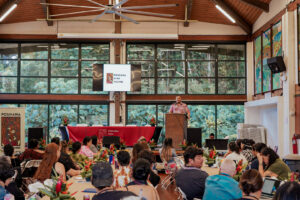
This conference was born from a deep need to return home—not just to Koʻolaupoko as a physical place, but to the foundational values and principles that have sustained us as a people for generations. In an increasingly globalized world, we are often pulled in many directions, and it can be easy to lose sight of who we are, where we come from, and what truly matters.
The idea of “Hoʻi i ka hale,” or returning home, is not just about going back to a place; it is about re-centering ourselves in the values that have been passed down to us. It is about understanding that our strength lies in our roots, in the teachings of our kūpuna, and in the practices that have been honed over centuries.
As Hawaiians, we face unique challenges in this modern world. We are constantly navigating between the demands of the contemporary era and the wisdom of our ancestors. This conference is an opportunity to pause, to breathe, and to reconnect with the values that have sustained our people. It is a time to engage in deep reflection, to share our stories, and to learn from one another.
“Hoʻi i ka hale” is more than a theme—it is a call to action. It is a reminder that in order to move forward, we must first return to the source of our strength. We must draw from the wellspring of our culture, our traditions, and our ʻohana. This conference is a manifestation of that return—a gathering of minds, hearts, and spirits, all united by a common purpose: to strengthen our community, to honor our past, and to ensure a future where our children and grandchildren can thrive.
One of the central discussions we will engage in during this conference is the role of māhū within the ʻohana. In our culture, māhū hold a position of deep spiritual and social significance. They embody a balance of masculine and feminine energies, offering a unique perspective that enriches and strengthens the ʻohana.
Historically, māhū were respected as keepers of knowledge, as healers, and as mediators. We played a vital role in the continuity of our culture, ensuring that wisdom was passed down and that the social fabric of our communities remained intact. We were, and are, the weavers of harmony within the ʻohana, balancing the diverse needs and energies that coexist within our families.
However, the Western imposition of rigid gender norms and even a hijacking by certain nicheʻ groups has marginalized māhū, diminishing our role and erasing our contributions. This has not only harmed māhū ourselves but has also fractured the very foundations of our ʻohana. The loss of māhū as central figures in our communities has weakened the holistic understanding of family, community, and cultural identity.
In returning home, we must also return to an understanding of ʻohana that includes and honors māhū. We must recognize that our presence is not merely a matter of inclusion—it is essential to the health and well-being of our entire community. The balance that māhū brings to the ʻohana is a key component of our cultural resilience. It is through that wisdom, compassion, and spiritual insight that we can navigate the challenges we face and move forward as a united people.
Restoring māhū to their rightful place within the ʻohana is an act of cultural reclamation. An act of sovereignty. EA! It is a statement that we refuse to allow the erasure of our traditions, our identities, and our ways of being. It is a powerful reminder that the health of our ʻohana—and indeed, of our lāhui—depends on our ability to embrace all aspects of who we are, to celebrate our diversity, and to normalize the sacredness of every member of our community.
In today’s world, the concept of the “nuclear family” is often presented as the ideal—two parents and their children, living in isolation from the extended family. But for us as Hawaiians, the idea of ʻohana goes far beyond this narrow definition. ʻOhana is not just about blood relations; it is about the web of relationships that sustain us, the collective responsibility we share for one another’s well-being.
ʻOhana encompasses grandparents, aunties, uncles, cousins, and even those who are not related by blood but who are bound to us by the ties of kuleana. In ʻohana, we find strength in numbers, in diversity, and in the interconnectedness of our lives. The well-being of the individual is directly linked to the well-being of the whole, and it is through this understanding that we find the power to heal, to grow, and to thrive.
The nuclear family, in contrast, can often lead to isolation and fragmentation. It is a model that encourages self-reliance over interdependence, separation over connection. While it may work for some, it does not align with the values and practices that have sustained our people for centuries. In the context of our culture, the nuclear family is an incomplete model—it fails to recognize the importance of the collective, the community, and the broader network of support that is essential to our survival.
ʻOhana is not just a word, not just a concept—it is the very essence of who we are as Hawaiians. ʻOhana is the foundation upon which our entire society is built. It is the core of our identity, the source of our strength, and the heart of our cultural practices. Without ʻohana, there is no community, there is no culture, there is no Hawaiʻi.
The uniqueness of ʻohana lies in its inclusiveness, its expansiveness. Unlike the Western concept of the nuclear family, which is often limited to parents and children, ʻohana encompasses all those who are connected by blood, by love, and by shared responsibility. It is a system of relationships that binds us together, that ensures that no one is left behind, that everyone is cared for and supported.
But with this inclusiveness comes kuleana, a sacred responsibility. It is our kuleana to protect the ʻohana system, to nurture it, and to ensure that it remains central to all our practices and healing. If we lose sight of the importance of ʻohana, if we allow it to be eroded by outside influences or by our own neglect, then we risk losing everything that makes us who we are.
ʻOhana is not just about familial bonds—it is about the interconnectedness of our entire community. It is about recognizing that every individual is a vital part of the whole, that the well-being of one affects the well-being of all. It is about understanding that our survival, our success, and our future depend on the strength and unity of our ʻohana.
As we face the challenges of the modern world, we must remember that the survival of Hawaiʻi—our culture, our people, our way of life—depends on the survival of the ʻohana. We must be vigilant in protecting it, in nurturing it, and in ensuring that it remains at the center of everything we do.
This is our kuleana. This is our responsibility. And it is a responsibility that we must take seriously, for the sake of our ancestors, for the sake of our children, and for the sake of all those who will come after us.
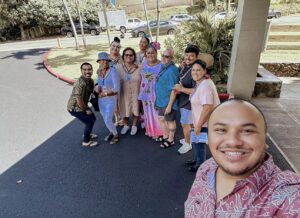 As we work to heal the wounds of colonization, we must reclaim and restore the concept of ʻohana. We must return to a way of life that honors the contributions of every member of the family, that recognizes the importance of connection, and that prioritizes the collective over the individual.
As we work to heal the wounds of colonization, we must reclaim and restore the concept of ʻohana. We must return to a way of life that honors the contributions of every member of the family, that recognizes the importance of connection, and that prioritizes the collective over the individual.
As we meet here, under the protection of Koʻolaupoko, let us remember that we are not just returning to a place—we are returning to a way of life, to a set of values that have sustained us for generations. We are returning to a deeper understanding of what it means to be Hawaiian, to be part of an ʻohana, and to be stewards of this land and each other.
Let us honor the mountains that have watched over us, the ʻohana that nurtures us, and the māhū who bring balance and harmony to our lives. Let us commit ourselves to the work of healing, of restoration, and of strengthening our lāhui.
“Hoʻi i ka hale”—let us return to home, to the place where we find strength, where we find healing, and where we find a sense of belonging. Let us return to the values that define us, to the practices that sustain us, and to the community that gives us life.
